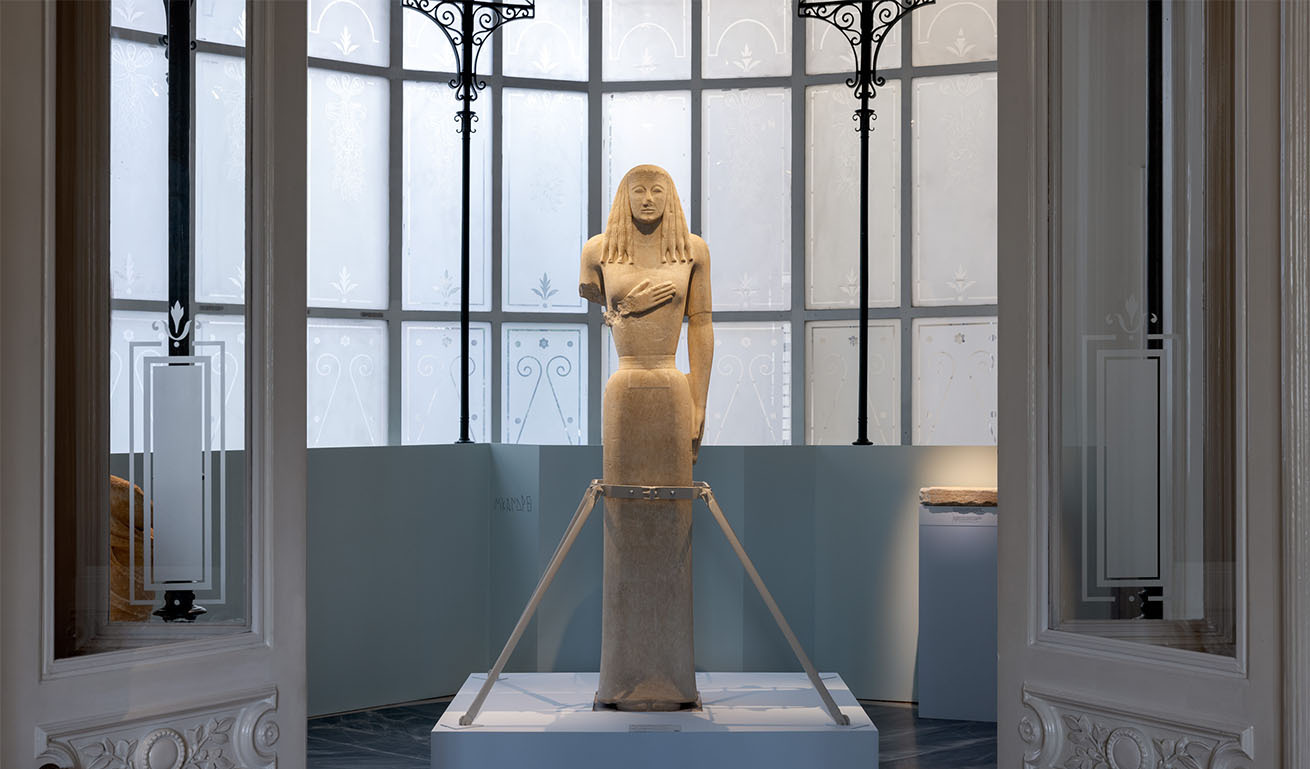EXHIBITIONS
MUSEUM OF CYCLADIC ART / ATHENS
Kykladitisses: Untold stories of women in the Cyclades
The Museum of Cycladic Art, presents the exhibition “Kykladitisses: Untold stories of women in the Cyclades” at the Stathatos Mansion, from December 12, 2024 until May 4, 2025. It’s the first pan-Cycladic exhibition ever organised, presents history through the eyes of the women of the Cyclades, from antiquity to the 19th century.
© Paris Tavitian. Museum of Cycladic Art. Marble colossal statue of a kore from Thera, 600-575 BC (?)
It is an exhibition that brings together in Athens 180 unique masterpieces from almost all the islands of the Cyclades: Amorgos, Andros, Delos, Thira, Ios, Kea, Kythnos, Milos, Mykonos, Naxos, Paros, Serifos, Sikinos, Sifnos, Syros, Tinos and Folegandros. The exhibits date from early prehistory to the 19th century and the birth of the Greek state. Unique works, most of which have never travelled either outside the Cyclades or outside the Museum of Cycladic Art; some have never before been presented to the public. Alongside the marble Cycladic figurines of the Early Cycladic period from the Museum of Cycladic Art, 135 exhibits from the collections of the Ephorate of Antiquities of Cyclades and artifacts from the Kanellopoulos Museum, the Epigraphic Museum of Athens, the Ephorate of Paleoanthropology and Speleology and important private collections are on display.
By focusing on women, as they emerge through the material testimonies of the Cycladic past, the exhibition aims to examine the roles of women and their positions in insular societies. This is achieved through revealing the smaller or larger ‘untold’ stories that they themselves tell us – either through their own words or through their material remains; but almost always through the filter of the view of men of their time. The exhibition thus brings to light the often unfamiliar roles of women over the years and demonstrates how these roles were influenced by their position of dependency. Deities and mothers, priestesses, courtesans, merchants, fighters, intellectuals, mourners, witches, immigrants.
The visitor will get to understand the Cycladic women both in public and in private life, in social, political, religious and family spheres. Within the twelve sections of the exhibition, their relationship with eroticism, death and mourning, their participation in religious events and Dionysian festivals, the violence they suffered and the restrictions imposed on them by the community, are all presented.
Statuettes and large-sized sculptures, vases, jewellery, coins, funerary stelae, inscriptions with legal texts, frescoes, mosaics, engravings, manuscripts and icons – ranging from prehistoric to post-Byzantine times – compose the exhibition.
Of the items, many of which could be, and are, exhibition objects by themselves, three works stand out due to their uniqueness and size: the colossal Kore of Thira (2.48 m high), one of the few almost intact Archaic statues, now exhibited for the first time in Greece; the emblematic fresco from Akrotiri in Santorini presenting the ‘Women in the Sanctuary’, a unique work of monumental dimensions (almost 4 m long); and the Hellenistic statue of Artemis Elaphebolos from Delos, which will be exhibited for the first time outside the island.
The exhibition is structured around the following 12 sections:
1. Juggling between genders
2. The origin of the world
3. Goddesses of the islands
4. Female apotropaic figures
5. In the sanctuaries
6. Goddesses of the sea
7. Female identities
8. From the Oikoumene to the Archipelago
9. Eroticism
10. Violence
11. Death through their own eyes
12. Faces
The exhibition is the second in the new series of archaeological exhibitions with the theme of ‘Human Histories’ at the Museum of Cycladic Art. These tell and illustrate stories about the lives, customs and works of mortals, which yet influence the lives, perceptions and thoughts of later generations.




